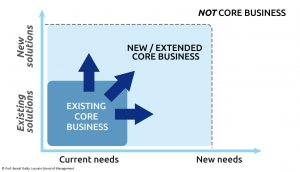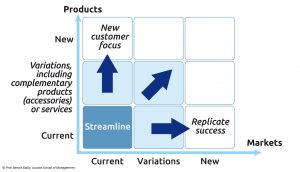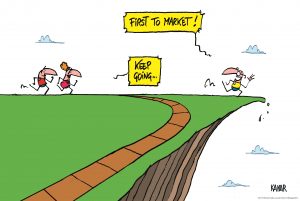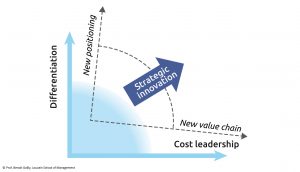NEW: Watch the executive summary
The first way to develop an innovation strategy is to (re)define where the firm wants to compete, what it defines as being part of its (new) “core business”. Specifically, this means finding new ways to explore – not just exploit – and reconfigure its business portfolio.
The second way to develop an innovation strategy is to redefine how the firm wants its businesses to compete and which product/market positioning and value chain it wants them to build and sustain.

A key element of an innovation strategy is to understand that first is not always best. A firm should assess and define how quickly it wants to enter new business areas and manage innovation accordingly.

One high-risk/high-potential innovation strategy is to challenge generic strategies and define and implement a “strategic innovation,” a radical redefinition of where and how a firm wants to compete and shape its future.

Bibliography
Innovative corporate strategies: (re)define the core business
Keywords: adjacent opportunities, BCG matrix, business portfolio, core business, corporate strategy, directions of development, diversification, exploration/exploitation, GE-McKinsey matrix, playground, strategy
- (Book) Foster, R., & Kaplan, S. (2011). Creative Destruction: Why Companies That Are Built to Last Underperform the Market–And How to Success fully Transform Them. Crown Business.
- (Book) Hamel, G. and Prahalad, C.K. (1994) Competing for the future, Harvard Business School Press
- (Book) Robertson, D., & Breen, B. (2013), Brick by brick: How LEGO rewrote the rules of innovation and conquered the global toy industry. Crown Business.
- (Book) Schulze, P. (2009). Balancing exploitation and exploration: Organizational antecedents and performance effects of innovation strategies. Springer.
- (Book) Verganti, R. (2017). Overcrowded: designing meaningful products in a world awash with ideas. MIT Press.
- (Book) Zook, C., & Allen, J. (2001), Profit from the Core. Boston, MA: Harvard Business School Press.
- (Video) Knut Haanaes: Two reasons companies fail — and how to avoid them (TED talk)
- (Article) Anthony, S. D., Eyring, M., & Gibson, L. (2006). Mapping your innovation strategy. Harvard Business Review, 84(5), 104-13.
- (Article) Aspara, J., Lamberg, J. A., Laukia, A., & Tikkanen, H. (2013). Corporate business model transformation and inter-organizational cognition: The case of Nokia. Long Range Planning, 46(6), 459-474.
- (Article) Barnett, W. P., Greve, H. R., & Park, D. Y. (1994). An evolutionary model of organizational performance. Strategic Management Journal, 15(S1), 11-28.
- (Article) Bowman, E. H., & Helfat, C. E. (2001). Does corporate strategy matter?. Strategic Management Journal, 22(1), 1-23.
- (Article) Calandro, J., & Paharia, V. (2019). Disruptive technologies, “Black Swans” and corporate innovation strategy. Strategy & Leadership.
- (Article) Cheng, Y.T. & Van de Ven A.H. (1996). Learning the innovation journey: order out of chaos? Organization Science, 7(6), 593-614.
- (Article) Clausen, T. H., Korneliussen, T., & Madsen, E. L. (2013). Modes of innovation, resources and their influence on product innovation: Empirical evidence from R&D active firms in Norway. Technovation , 33 (6-7), 225-233.
- (Article) Day, G. S., & Schoemaker, P. J. (2004). Driving through the fog: managing at the edge. Long Range Planning, 37(2), 127-142.
- (Article) Eggers, J. P., & Kaplan, S. (2009). Cognition and renewal: Comparing CEO and organizational effects on incumbent adaptation to technical change. Organization Science, 20(2), 461-477.
- (Article) Fitzgerald, T., Balsmeier, B., Fleming, L., & Manso, G. (2020). Innovation search strategy and predictable returns. Management Science.
- (Article) Furrer, O., Thomas, H., & Goussevskaia, A. (2008). ‘The structure and evolution of the strategic management field: a content analysis of 26 years of strategic management research’. International Journal of Management Reviews, 10, 1-23.
- (Article) Galunic, D. C., & Eisenhardt, K. M. (2001). Architectural innovation and modular corporate forms. Academy of Management Journal, 44(6), 1229-1249.
- (Article) Gassmann, O., Widenmayer, B., & Zeschky, M. (2012). Implementing radical innovation in the business: the role of transition modes in large firms. R&D Management, 42(2), 120-132.
- (Article) Gavetti, G., Levinthal, D. A., & Rivkin, J. W. (2005). Strategy making in novel and complex worlds: The power of analogy. Strategic Management Journal, 26(8), 691-712.
- (Article) Greve, H. (2007). Exploration and Exploitation in Product Innovation. Industrial and Corporate Change, 16(5), 945-975.
- (Article) Gupta, A. K., Smith, K. G., & Shalley, C. E. (2006). The interplay between exploration and exploitation. Academy of Management Journal, 49(4), 693-706.
- (Article) Helfat, C. E., & Eisenhardt, K. M. (2004). Inter‐temporal economies of scope, organizational modularity, and the dynamics of diversification. Strategic Management Journal, 25(13), 1217-1232.
- (Article) He, Z. L., & Wong, P. K. (2004). Exploration vs. exploitation: An empirical test of the ambidexterity hypothesis. Organization Science, 15(4), 481-494.
- (Article) Henderson, R. (1993). Underinvestment and incompetence as responses to radical innovation: Evidence from the photolithographic alignment equipment industry. The RAND Journal of Economics, 248-270.
- (Article) Jansen, J. J., Van Den Bosch, F. A., & Volberda, H. W. (2006). Exploratory innovation, exploitative innovation, and performance: Effects of organizational antecedents and environmental moderators. Management Science, 52(11), 1661-1674.
- (Article) Kaplan, S. (2011). Research in cognition and strategy: Reflections on two decades of progress and a look to the future. Journal of Management Studies, 48(3), 665-695.
- (Article) Kaplan, S., & Orlikowski, W.J. (2013). Temporal work in strategy making. Organization Science, 24(4), 965-995.
- (Article) Kim, S. K., Arthurs, J. D., Sahaym, A. and Cullen, J. B. (2013). Search behavior of the diversified firm: The impact of fit on innovation. Strategic Management Journal, 34, 999–1009. doi:10.1002/smj.2038
- (Article) Lavie, D., Stettner, U., & Tushman, M.L. (2010). Exploration and Exploitation Within and Across Organizations. Academy of Management Annals, 4, 109-155.
- (Article) Lennerts, S., Schulze, A., & Tomczak, T. (2019). The asymmetric effects of exploitation and exploration on radical and incremental innovation performance: An uneven affair. European Management Journal.
- (Article) Levinthal, D. A. (2011). A behavioral approach to strategy—what’s the alternative?. Strategic Management Journal, 32(13), 1517-1523.
- (Article) Makri, M., & Scandura, T. A. (2010). Exploring the effects of creative CEO leadership on innovation in high-technology firms. The Leadership Quarterly, 21(1), 75-88.
- (Article) Mueller, V., Rosenbusch, N., & Bausch, A. (2013). Success patterns of exploratory and exploitative innovation: A meta-analysis of the influence of institutional factors. Journal of Management, 39(6), 1606-1636.
- (Article) Phillips, N., Lawrence, T. B., & Hardy, C. (2004). Discourse and institutions. Academy of Management Review, 29(4), 635-652.
- (Article) Piao, M., & Zajac, E. J. (2016). How exploitation impedes and impels exploration: Theory and evidence. Strategic Management Journal, 37(7), 1431-1447.
- (Article) Prahalad, C. K. (2004). The blinders of dominant logic. Long Range Planning, 37(2), 171-179.
- (Article) Raffaelli, R., Glynn, M. A., & Tushman, M. (2019). Frame flexibility: The role of cognitive and emotional framing in innovation adoption by incumbent firms. Strategic Management Journal, 40(7), 1013-1039.
- (Article) Rijamampianina, R., Abratt, R., & February, Y. (2003). A framework for concentric diversification through sustainable competitive advantage. Management Decision, 41(4), 362-371.
- (Article) Robins, J., & Wiersema, M. F. (1995). A resource‐based approach to the multibusiness firm: Empirical analysis of portfolio interrelationships and corporate financial performance. Strategic Management Journal, 16(4), 277-299.
- (Article) Rothaermel, F.T., & Deeds, D. (2004). Exploration and exploitation alliances in biotechnology: A system of new product development. Strategic Management Journal, 25 (3), 201-221.
- (Article) Rothaermel, F. T., & Alexandre, M. T. (2009). Ambidexterity in technology sourcing: The moderating role of absorptive capacity. Organization science, 20(4), 759-780.
- (Article) Smith, W. K., Binns, A., & Tushman, M. L. (2010). Complex business models: Managing strategic paradoxes simultaneously. Long Range Planning, 43(2-3), 448-461.
- (Article) Stettner, U., & Lavie, D. (2014). Ambidexterity under scrutiny: Exploration and exploitation via internal organization, alliances, and acquisitions. Strategic management journal, 35(13), 1903-1929.
- (Article) Suddaby, R., & Greenwood, R. (2005). Rhetorical strategies of legitimacy. Administrative Science Quarterly, 50(1), 35-67.
- (Article) Uotila, J., Maula, M., Keil, T., & Zahra, S. A. (2009). Exploration, exploitation, and financial performance: analysis of S&P 500 corporations. Strategic Management Journal, 30(2), 221-231.
- (Article) Wan, W., Hoskisson, R., Short, J., & Yiu, D. (2011). ‘Resource-based theory and corporate diversification: accomplishments and opportunities’. Journal of Management, 37, 1335-1368.
- (Article) Zhou, K. Z., & Wu, F. (2010). Technological capability, strategic flexibility, and product innovation. Strategic Management Journal, 31(5), 547-561.
- (Article) Zook, C. (2007). Finding your next core business. Harvard Business Review, 85(4), 66-75.
Innovative business strategies: redefine how to compete
Keywords: Ansoff matrix, business strategy, business value chain, cost leadership, disintermediation, industry value chain, intermediation, product/market strategy
- (Book) Porter, Michael E. (1985). Competitive Advantage: Creating and Sustaining Superior Performance. New York.: Simon and Schuster..
- (Book) Skarzynski, P. & Gibson, R. (2008) Innovation to the core, Harvard Business Press
- (Book) Teixeira, T. S., & Piechota, G. (2019). Unlocking the Customer Value Chain: How Decoupling Drives Consumer Disruption. Broadway Business.
- (Video) Stanford Course – Innovating Through Value Chains
- (Article) Adner, R., & Kapoor, R. (2010). Value creation in innovation ecosystems: How the structure of technological interdependence affects firm performance in new technology generations. Strategic management journal, 31(3), 306-333.
- (Article) Chesbrough, H. & Rosenbloom, R. S. (2002). “The role of the business model in capturing value from innovation: evidence from Xerox Corporation’s technology spin-off companies“ Industrial and Corporate Change, 11(3), 529-555.
- (Article) Globocnik, D., Faullant, R., & Parastuty, Z. (2020). Bridging strategic planning and business model management–A formal control framework to manage business model portfolios and dynamics. European Management Journal, 38(2), 231-243.
- (Article) Hughes, M., Martin, S. L., Morgan, R. E., & Robson, M. J. (2010). Realizing product-market advantage in high-technology international new ventures: The mediating role of ambidextrous innovation. Journal of International Marketing, 1-21.
- (Article) Ireland, R.D., Covin, J.G., & Kuratko, D.F. (2009). Conceptualizing corporate entrepreneurship strategy. Entrepreneurship Theory and Practice, 33(1), 19-46.
- (Article) Ireland, R. D., & Webb, J. W. (2007). Strategic entrepreneurship: Creating competitive advantage through streams of innovation. Business horizons, 50(1), 49-59.
- (Article) Lee, J., & Berente, N. (2012). Digital innovation and the division of innovative labor: Digital controls in the automotive industry. Organization Science, 23(5), 1428-1447.
- (Article) Markides, C. C. (1999). A dynamic view of strategy. Sloan Management Review, 40(3), 55.
- (Article) Miller, D. (1987). The structural and environmental correlates of business strategy. Strategic Management Journal, 8(1), 55-76.
- (Article) Mintzberg, H. (1987). The strategy concept I: Five Ps for strategy. California Management Review, 30(1), 11-24.
- (Article) Ragatz, G. L., Handfield, R. B., & Petersen, K. J. (2002). Benefits associated with supplier integration into new product development under conditions of technology uncertainty. Journal of Business Research, 55(5), 389-400.
- (Article) Sawhney, M., Wolcott, R. C., & Arroniz, I. (2006). The 12 different ways for companies to innovate. MIT Sloan Management Review, 47(3), 75.
- (Article) Winterhalter, S., Zeschky, M. B., & Gassmann, O. (2016). Managing dual business models in emerging markets: An ambidexterity perspective. R&D Management, 46(3), 464-479.
- (Article) Wise, R., & Baumgartner, P. (1999). Go downstream. Harvard Business Review, 77(5), 133-141.
- (Article) Zott, C., & Amit, R. (2008). The fit between product market strategy and business model: implications for firm performance. Strategic Management Journal, 29(1), 1-26.
Timing: first is not always best
Keywords: experience curve, incumbent, first mover (dis)advantage, follower, imitation, learning curve, lock-in, network effect, persistence of innovation, switching costs
- (Book) Markides, C. C., & Geroski, P. A. (2004). Fast second: How smart companies bypass radical innovation to enter and dominate new markets (Vol. 325). John Wiley & Sons.
- (Book) Schilling M.A. (2006) Strategic Management of Technological Innovation (2d ed.) McGraw-Hill, Irwin
- (Video) The Zinnovants “First is not always best”
- (Article) Afuah, A. (2013). Are network effects really all about size? The role of structure and conduct. Strategic Management Journal, 34(3), 257-273.
- (Article) Argote, L., & Epple, D. (1990). Learning curves in manufacturing. Science, 247(4945), 920-924.
- (Article) Arrow, K. J. (1962). The economic implications of learning by doing. The Review of Economic Studies, 29(3), 155-173.
- (Article) Arthur, W. B. (1989). Competing technologies, increasing returns, and lock-in by historical events. The Economic Journal, 99(394), 116-131.
- (Article) Bayus, B. L., & Agarwal, R. (2007). The role of pre-entry experience, entry timing, and product technology strategies in explaining firm survival. Management Science, 53(12), 1887-1902.
- (Article) Boudreau, K. J., & Jeppesen, L. B. (2015). Unpaid crowd complementors: The platform network effect mirage. Strategic Management Journal, 36(12), 1761-1777.
- (Article) Christensen, C.M., & Rosenbloom, R.S. (1995). Explaining the attacker’s advantage: Technological paradigms, organizational dynamics, and the value network. Research Policy, 24(2), 233-257.
- (Article) Coeurderoy, R., & Durand, R. (2004). Leveraging the advantage of early entry: proprietary technologies versus cost leadership. Journal of Business Research, 57(6), 583-590.
- (Article) Covin, J. G., Slevin, D. P., & Heeley, M. B. (2000). Pioneers and followers: Competitive tactics, environment, and firm growth. Journal of Business Venturing, 15(2), 175-210.
- (Article) Dowell, G., & Swaminathan, A. (2006). Entry timing, exploration, and firm survival in the early US bicycle industry. Strategic Management Journal, 27(12), 1159-1182.
- (Article) Enkel, E., & Mezger, F. (2013). Imitation processes and their application for business model innovation: An explorative study. International Journal of Innovation Management, 17(01), 1340005.
- (Article) Franco, A. M., Sarkar, M. B., Agarwal, R., & Echambadi, R. (2009). Swift and smart: The moderating effects of technological capabilities on the market pioneering–firm survival relationship. Management Science, 55(11), 1842-1860.
- (Article) Ganter, A., & Hecker, A. (2013). Persistence of innovation: discriminating between types of innovation and sources of state dependence. Research Policy, 42(8), 1431-1445.
- (Article) Golder, P. N., & Tellis, G. J. (1993). Pioneer advantage: Marketing logic or marketing legend?. Journal of Marketing Research, 30(2), 158-170.
- (Article) Grewal, R., Cline, T. W., & Davies, A. (2003). Early‐entrant advantage, word‐of‐mouth communication, brand similarity, and the consumer decision‐making process. Journal of Consumer Psychology, 13(3), 187-197.
- (Article) Heeley, M. B., & Jacobson, R. (2008). The recency of technological inputs and financial performance. Strategic Management Journal, 29(7), 723-744.
- (Article) Henderson, R. (2006). The innovator’s dilemma as a problem of organizational competence. Journal of Product Innovation Management, 23(1), 5-11.
- (Article) Hill, C. W., & Rothaermel, F. T. (2003). The performance of incumbent firms in the face of radical technological innovation. Academy of Management Review, 28(2), 257-274.
- (Article) Jain, A. (2013). Learning by doing and the locus of innovative capability in biotechnology research. Organization Science, 24(6), 1683-1700.
- (Article) King, A. A., & Tucci, C. L. (2002). Incumbent entry into new market niches: The role of experience and managerial choice in the creation of dynamic capabilities. Management Science, 48(2), 171-186.
- (Article) Klepper, S., & Simons, K. L. (2000). Dominance by birthright: entry of prior radio producers and competitive ramifications in the US television receiver industry. Strategic Management Journal, 21(10‐11), 997-1016.
- (Article) Lafond, F., Bailey, A. G., Bakker, J. D., Rebois, D., Zadourian, R., McSharry, P., & Farmer, J. D. (2018). How well do experience curves predict technological progress? A method for making distributional forecasts. Technological Forecasting and Social Change, 128, 104-117.
- (Article) Lee, G. K. (2009). Understanding the timing of ‘fast-second’entry and the relevance of capabilities in invention vs. commercialization. Research Policy, 38(1), 86-95.
- (Article) Levitt, S. D., List, J. A., & Syverson, C. (2013). Toward an understanding of learning by doing: Evidence from an automobile assembly plant. Journal of Political Economy, 121(4), 643-681.
- (Article) Lieberman M.B., & Montgomery D. B. (1988). First-Mover Advantages. Strategic Management Journal, Vol. 9, Special Issue: Strategy Content Research. (Summer, 1988), 41-58.
- (Article) Lilien, G. L., & Yoon, E. (1990). The timing of competitive market entry: An exploratory study of new industrial products. Management Science, 36(5), 568-585.
- (Article) Madsen, T., & Leiblein, M. (2015). What Factors Affect the Persistence of an Innovation Advantage? Journal of Management Studies, 52, 1098-1127.
- (Article) Markides, C., & Sosa, L. (2013). Pioneering and first mover advantages: the importance of business models. Long Range Planning, 46(4), 325-334.
- (Article) Marx, M., Gans, J. S., & Hsu, D. H. (2014). Dynamic commercialization strategies for disruptive technologies: Evidence from the speech recognition industry. Management Science, 60(12), 3103-3123.
- (Article) McElheran, K. (2015). Do market leaders lead in business process innovation? The case (s) of e-business adoption. Management Science, 61(6), 1197-1216.
- (Article) Ordanini, A., Rubera, G., & DeFillippi, R. (2008). ‘The many moods of inter-organizational imitation: a critical review’. International Journal of Management Reviews, 10, 375-398.
- (Article) Reinganum, J. F. (1983). Uncertain innovation and the persistence of monopoly. The American Economic Review, 73(4), 741-748.
- (Article) Sharapov, D., & Ross, J. M. (2019). Whom should a leader imitate? Using rivalry‐based imitation to manage strategic risk in changing environments. Strategic Management Journal.
- (Article) Sheremata, W. A. (2004). Competing through innovation in network markets: Strategies for challengers. Academy of Management Review, 29(3), 359-377.
- (Article) Urban, G.L., Carter, T., Gaskin, S., & Mucha, Z. (1986). Market share rewards to pioneering brands: An empirical analysis and strategic implications. Management Science, 32(6), 645-659.
- (Article) Vidal, E., & Mitchell, W. (2013). When do first entrants become first survivors?. Long Range Planning, 46(4-5), 335-347.
Off the beaten paths: strategic innovations
Keywords: Blue Ocean strategy, strategic innovation
- (Book) Chan Kim, W. & Mauborgne, R. (2005) Blue Ocean Strategy: How to Create Uncontested Market Space and Make the Competition Irrelevant Harvard Business School Press
- (Book) Govindarajan V. & Trimble Ch. (2007) “10 Rules for Strategic Innovators: From Idea to execution” Harvard Business School Press Boston, Massachusetts
- (Book) Markides, C. C. (1999) All the right moves: a guide to crafting breakthrough strategy, Cambridge MA, Harvard Business School Press
- (Book) Markides, C. C. (2013). Game-changing strategies: How to create new market space in established industries by breaking the rules. John Wiley & Sons.
- (Video) What is Blue Ocean Strategy? Harvard Business Review
- (Video) What is strategic innovation? – Professor Costas Markides
- (Video) 7 Keys to Strategic Innovation. Educause, 2016
- (Article) Assink, M. (2006),”Inhibitors of disruptive innovation capability: a conceptual model”, European Journal of Innovation Management, Vol. 9 Iss: 2 pp. 215 – 233
- (Article) Chan Kim, W., & Mauborgne, R. (2004). Value innovation: The strategic logic of high growth. Harvard Business Review, 82(7-8), 172-180.
- (Article) Choi, D., & Valikangas, L. (2001). Patterns of strategy innovation. European Management Journal, 19(4), 424-429.
- (Article) Cortimiglia, M. N., Ghezzi, A., & Frank, A. G. (2016). Business model innovation and strategy making nexus: evidence from a cross‐industry mixed‐methods study. R&D Management, 46(3), 414-432.
- (Article) Francis, D., & Bessant, J. (2005). Targeting innovation and implications for capability development. Technovation, 25(3), 171-183.
- (Article) Giesen, E., Riddleberger, E., Christner, R., & Bell, R. (2010). When and how to innovate your business model. Strategy & leadership. 38(4), 17-26
- (Article) Govindarajan, V., & Trimble, C. (2004). Strategic innovation and the science of learning. MIT Sloan Management Review, 45(2), 67.
- (Article) Hamel (1998) “Strategy innovation and the quest for value”, Sloan Management Review, 39, p. 78
- (Article) Markides, C. (1998). Strategic innovation in established companies. Sloan Management Review, 39(3), 31-42
- (Article) Markides, C., & Charitou, C. D. (2004). Competing with dual business models: A contingency approach. Academy of Management Perspectives, 18(3), 22-36.
- (Article) Schlegelmilch et al. (2003) ‘Strategic innovation: The construct, its drivers and its strategic outcomes’, Journal of Strategic Marketing, vol. 11, p. 117-132
(c) Prof. Benoit Gailly, Louvain School of Management


